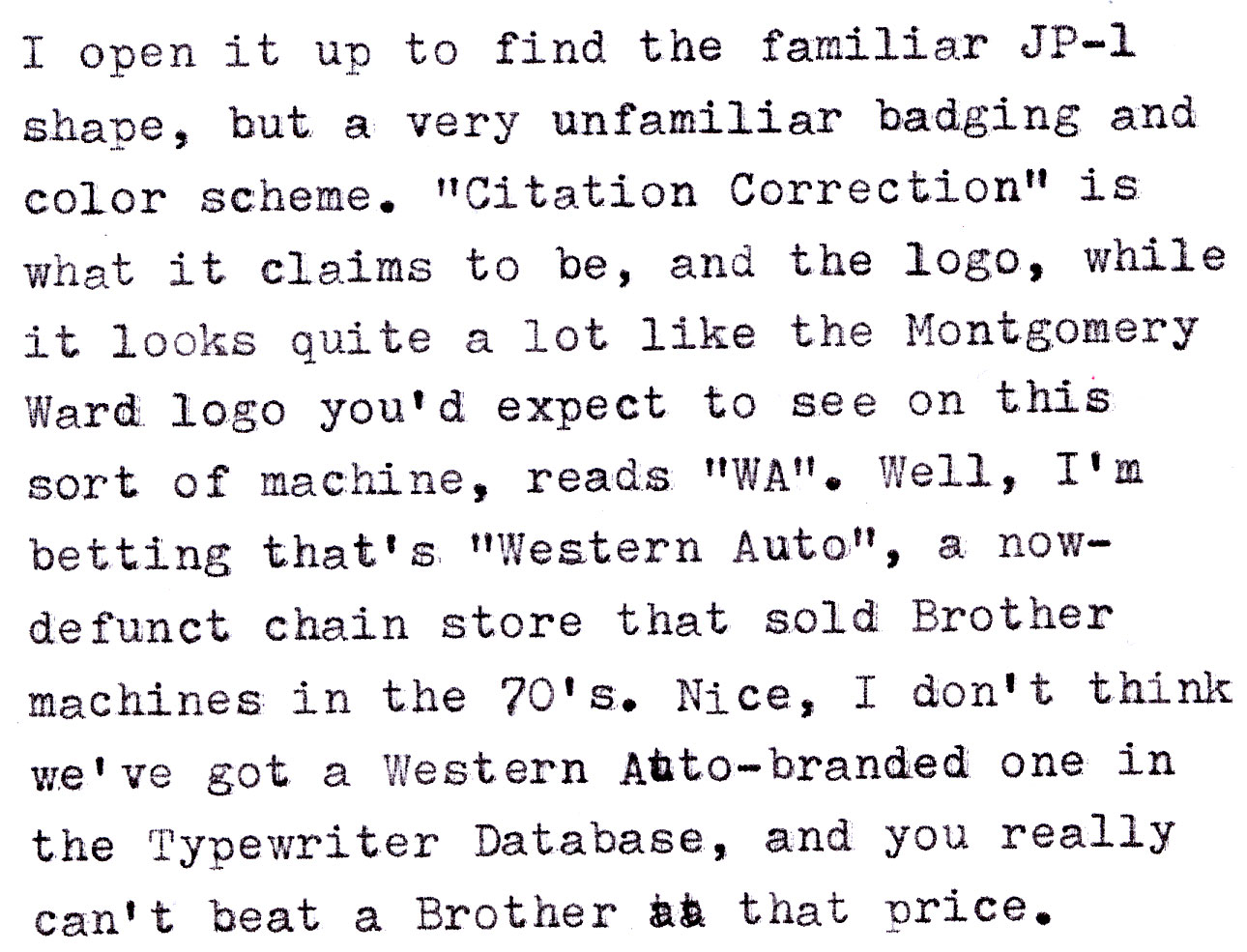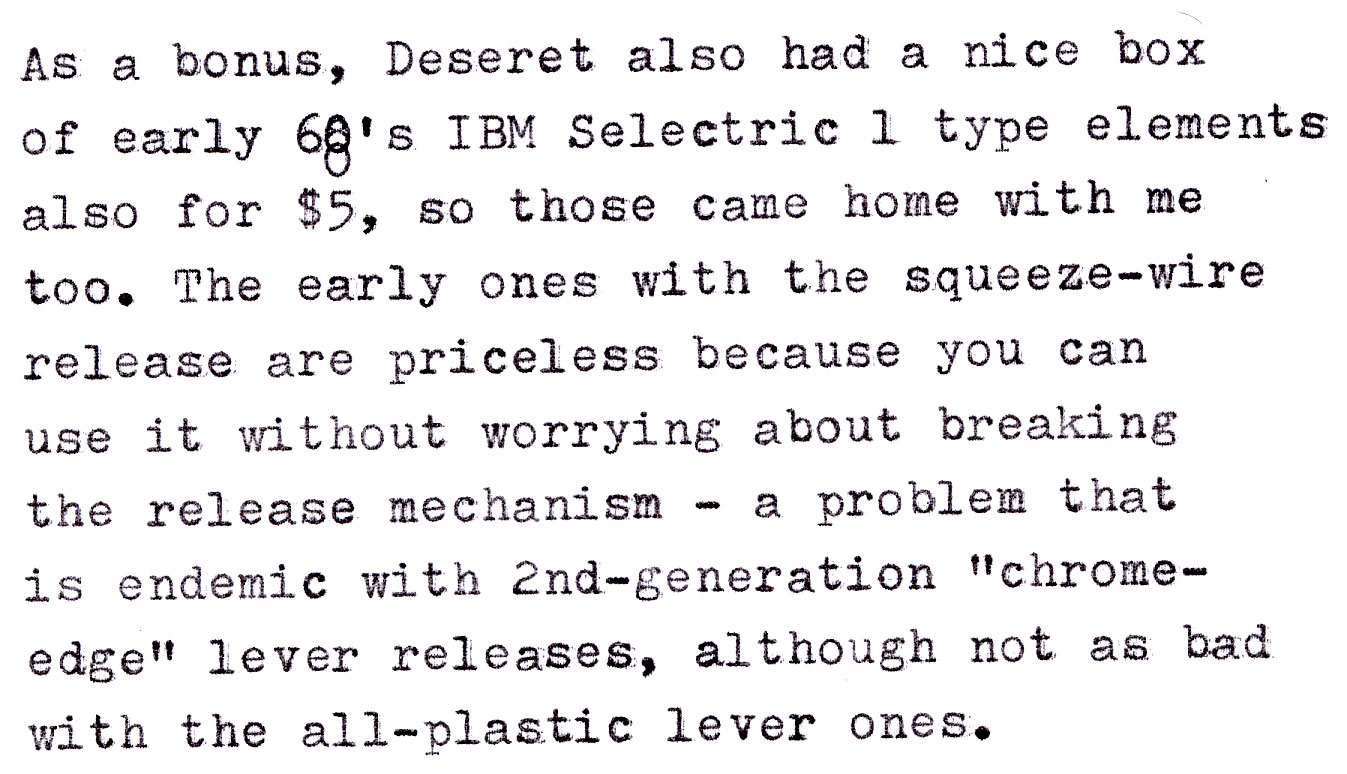 1980 Western Auto logo?
1980 Western Auto logo?







I know I say 1970 here, but I’m beginning to think that Brother switched the JP-1 to black keys from white and lost the paper rest and metal carriage shell sometime in the late 70’s. If true, it means we would be able to figure out what decade (roughly) a JP-1 was made in by the color of it’s keys and if it has a paper rest or not. If so, this would be a 1980 machine.
EDIT: further research confirms this is a 1980 machine. Compare Western Auto logos from ads from 1970 and 1980:
 I kind of think this machine has just provided me with an important clue to figuring out the decade a JP-1 was made in. My theory?
I kind of think this machine has just provided me with an important clue to figuring out the decade a JP-1 was made in. My theory?
Wire Loop paper rest & White keys = early-mid 60’s
Straight bar paper rest on spring & White keys = mid 60’s-early/mid 70’s
No paper rest & Black keys = mid/late 70’s-early/mid 80’s

2nd-Generation “Chrome-Edge Lever” ball. These are almost always broken when found and should be avoided unless it’s a typeface you can’t live without. If the lever isn’t completely broken off, it’s broken enough that the ball won’t open up for installation/de-installation. Avoid, avoid, avoid!













Just my cup of tea, since I have a few Brothers and also a few IBM balls. Sadly, mine are all third generation and I’ve managed to bust two of them already. Love the “Squeeze wire ” ones! Must find….
The item next to your yarn baller is a yarn winder. It produces those upright tapered spindles that used to be popular in the 70’s.
A Citation! What a find.
Your theory makes sense. My Brother Bradford, with wire paper rest, has a serial number of P149534, dating it to 1961. I located an advertisement that places the wire paper rest model to 1963 — it cost $36 then. See http://type-writer.org/?p=2287
Excellent! I wish I had one of the early 60’s models to do a complete comparison of features, but I’m becoming very convinced that the theory is sound.
So far, I’m seeing evidence of 3 major design shifts in the JP1 series:
1961-1964: wire loop rest, white keys. Brother only produced JP1 in this period.
1964: introduced straight bar rest, split JP-1 into 2 (or 3) different variations. Brother introduces JP2 and JP3 (possibly JP4 as well). These run until 1974, when Brother begins another design shift.
1974-75: Brother redesigns the JP-1, switches to black keys and black plastic carriage shell. I show some evidence that a few models kept the bar paper rest, but most didn’t. At this point, Brother definitely produces 3 major JP1 product groupings. JP2 and JP4 are re-designed (slightly), and JP3 is discontinued. JP5 and JP7 introduced (almost certainly the JP-8 as well, but I see only a single mention of it – no idea what it looks like other than it’s an electric typebar. I’ve found no mention of a JP6, which by Brother’s obvious model numbering plan would have also been an electric typebar machine.
1977: Brother discontinues some JP1 body styles, notably the 800 series (the ones with the taller ribbon covers.) I believe a few more were discontinued in 1979. I suspect that Brother had winnowed the JP1 back down to a single design variation again by then, and were just switching features on the same chassis.
198x: JP-1 discontinued, possibly the JP-5 and JP7 continue, but I’ve found no evidence that suggests any JP1 exists that is newer than 1982 or so. I would guess that Brother did another major product line overhaul in the mid-80’s (84/85?). I’ll know more when I dig into the service manuals for that decade.
hey mister munk. i’m confused as to what’s a jp2, jp3, etc. the jp1 machines are obvious, but i’ve seen the larger portables with more functionalities (like the brother de luxe 900 & montgomery ward signature 510) called jp3 machines, but the middle-sized design (remington 666, signature 440T) is what? i’d figure they’re jp2 but read somewhere the jp2 was electric. as for anything above jp3, i’m lost.
as it seems you know what’s what here, would you care to educate me — and surely many others — with a photo example of each of the jp designations?
thank you most sincerely.
peace out!
JP-2 and JP-3 are the large Brother machines with push-button bichrome selector – JP-2 is electric, JP-3 is manual. The Rem 666 and MW 440T are JP-1 in a “highbrow” shell, but are internally the same as any other JP-1. JP-4 is the low-profile electric. Specifics here:
https://typewriterdatabase.com/brother.10.typewriter-serial-number-database